February 18, 1982
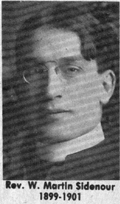
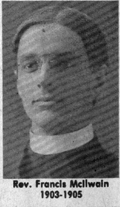
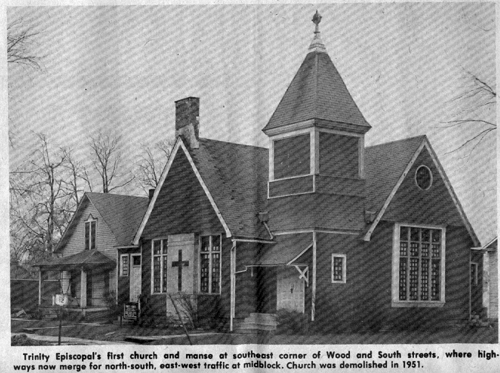
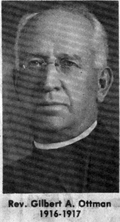
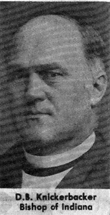
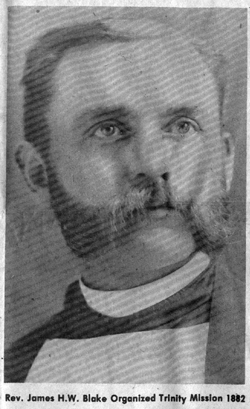
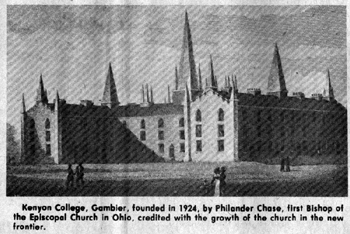
Picture #1 – Rev. W. Martin Sidenour 1899-1901
Picture #2 – Rev. Francis Mcllwain
Picture #3 – Trinity Episcopal’s first church and manse at southeast corner of Wood and South streets, where highways now merge for north-south, east west traffic at midblock. Church was demolished in 1951.
Picture #4 – Rev. Gilbert A. Ottman 1916-1917
Picture #5 – D.B. Knickerbacker Bishop of Indiana
Picture #6 – Rev. James H.W. Blake organized Trinity Mission 1882.
Picture #7 – Kenyon College, GAmbler, founded in 1924, by Philander Chase, first Bishop of the Episcopal Church in Ohio, credited with the growth of the church in the new frontier.
Most human endeavors are wrought with a high price tag…and often only with much sweat, tears, disappointment and anxieties. That goes for the churches today with roots that go back to early America.
The local Trinity Episcopal Church was no exception. Its ancestral history goes back to the American Colonies. For a century and a half in this country it bore the name of the Church of England, of which it was a part. Going back still earlier, its history dates back to the first missionaries who went to the British Isles from Gaul, prior to the Council of Aries in A.D. 314.
In the Southern colonies of America, the Church of England quickly became the established church; and William and Mary College was established in 1693. Other Anglican churches established early were: King’s Chapel, Boston, 1689; Trinity Church in New York City, 1698; nad one in Newport, R.I. that same year. By 1702, 50 clergymen were at work from the Carolinas to Maine, spreading the gospel and the tenets of that church.
COLONIAL CHURCH DIED
The Revolution nearly destroyed the Colonial Church of England within the colonies because the clery had made an oath of allegiance to the King of England. Many of the church leaders were loyal to the American cause, such as Rev. William White, chaplain of the Continental Congress, and the Rev. Charles Thurston, who was a colonel in the Continental Army. Other Continental leaders who were members of that church were: Washington, Jefferson, Patrick Henry, John Hay, Robert Morris, John Marshall, John Randolph, and Charles and Harry Lee.
At the end of the Revolutionary War, because of the division among the Anglicans, there was no government of the church, no association of churches not even the semblance of an establishment. Few thought there was any future for the church. There was, however, and a great one as the records show, as does the presence of the Episcopal church today.
In 1782, the Rev. William White, mentioned earlier, wrote a pamphlet a plea for unity and reorganization. As a result, in 1783, a conference of church leaders assembled at Annapolis, MD. and renamed the church the Protestant Episcopal Church. It eventually became a self-governing branch of the Anglican Communion. Various American clergy were later consecrated as bishops for various areas in America.
REORGANIZED IN 1789
In 1789 the constitution of the Protestant Episcopal Church was adopted in Philadelphia. There followed the establishment of new churches, theological seminaries colleges and domestic and foreign missionary societies.
Bishops moved into the new west. Philander Chase came to Ohio and worked miracles in overcoming the Revolutionary prejudices. Chase was the first bishop of Ohio. He founded Kenyon College at Gamler in 1924. The original structure with its Gothic architecture burned in 1949 but was immediately rebuilt, using many of the old stones to make the new building.
Chase and Kenyon College had a great influence in the acceptance and growth of the Episcopal Church throughout Ohio.
In the spring of 1888, the Rev. A.B. Nichols, Archdeacon and general missionary of the Diocese of Ohio, found a few communicants of the church in Fostoria and announced that he would hold services every two weeks on Friday nights. He hoped to bring strength and comfort to those who were without the blessing of the church.
LOCAL MISSION IN 1888
The first service was held in the chapel of the Fostoria Academy, April 3, 1888. Leaflets took the place of prayer books for the 30 people present. He held five services in the academy and then placed the work in the hands of the Rev. James H.W. Blake, rector of Trinity Church, Tiffin, who held one more service in the academy. A mission soon afterward was organized and named “Trinity” with Dr. George L. Hoege and Mrs. W.S. Brady as the missionary committee. The YMCA room in the Foster Block was rented for services.
The Rev. James Blake officiated at services every Wednesday evening until the aid of Harold Morse, a lay reader, was secured. He held his first service Sunday morning, Feb. 24, 1889. Morse was the assistant to the Rev. Blake, who visited the mission as often as possible. In October 1889, Morse moved to Toledo.
During Morse’s time of service, the Rt. Rev. Bishop D.B. Knickerbaker of the Diocese of Indiana confirmed the first class in the mission. The class consisted of Anna L. Hoege, Charlotte Louise Merrill, Edith Butterfield, Anna Graham, Dr. George L. Hoege, John Tompkin, John Walding, Emeline Walding, Theda Bell Noble, Mary Light, Amelia Prevot and Zoe Hachet.
CHURCH ERECTED 1890
A Sunday school was organized with Dr. George Hoege as superintendent.
In the fall of 1889 a lot 90 by 110 feet, on the southeast corner of Wood and South streets was purchased from J.F. Richert for $1,500. A frame church was erected thereon and formally opened and blessed on March 25, 1890.
On May 13, 1890, the first vestry was elected, consisting of Dr. George Hoege, senior warden; Mr. W.S. Brady, junior warden; L.B. Hitchcock, J.C. Butterfield and J.B. Graham.
The name “Trinity Parish” was adopted and a petition and papers prepared asking admission into the Diocese as an Independent Parish, which was granted by The Annual Convention held at Mt. Vernon May 21, 1890.
Several men were extended calls to the rectorate of the young parish and finally the Rev. D.F. Davies accepted the call. He took charge Jan. 14, 1891 and served until May 1, 1892, when he accepted a call to Mansfield, where he was made a deacon. In 1913 he became the Rev. Dr. Davies of Bexley Hall, Kenyon College, Gambier.
Davies was followed by the Rev. Hunter Davidson, the Rev. George Lyford Freebern and the Rev. Henry M. Green, the latter removed Jan 30, 1898.
BOOM AND BUST
During this period of Trinity, the church had done well as many people flocked to Fostoria to accept jobs resulting from the gas boom and ensuing industrial growth.
The church had grown to 125 communicants. Then the gas supply diminished, and the glass manufacturing plants which had moved here because of the free gas moved away. With them went many of Trinity’s members. The church’s membership dwindled to 60. There was an $800 mortgage left on the church building and the members became discouraged. Regular services were suspended from Jan. 30, 1898 to July 1, 1899.
Then on July 1, 1899, Mr. Martin Sidenour a layreader, was sent by the Bishop to what he termed “the most discouraging place in the Diocese”. In just one month a class of 11 was presented for confirmation. A vested choir was organized and the debt was paid off. Repairs were also made to the church.
Much had been accomplished by Sidenour when he went to the Christ Church in Detroit on Feb. 15, 1901.
NY RECTORS SERVED
From the time Martin Sidenour left in 1901 until 1922, there were 12 men in charge of Trinity for short periods of time. According to the old church records, the Rev. Edward J. Owen, who served as lay reader and deacon from March 5, 1905 until Dev. 10, 1908, made an excellent record by presenting a confirmation class of 22 candidates, 13 being converts.
Herman L. Sidenour, son of the Rev. William M. sidenour, an earlier rector of Trinity, took charge as a student from Bexley on Nov. 1, 1922. On June 17, 1923, he was ordained deacon and became the resident minister in charge. On Nov. 1, 1924, he resigned to become rector of Trinity Church, Tiffin, but while he was with the church new lighting fixtures were installed and Mrs. Jessie Richards donated a new electric organ in memory of her foster mother, Mary Ann Cole.
The Rev. Herman L. Sidenour was advanced to the priesthood at ordination services at St. Paul’s Church, Steubenville, conducted by Bishop Leonard on Nov. 1, 1924.
From 1924 to 1949, Bexley students, each served the church approximately two years, they included the Rev. H.H. Griffin from 1932-37. Then the Rev. Perry Blankenship arrived to serve from 1949-51 when he was succeeded by D.G. Stansbaugh from 1951-54.
The Rev. Earl D. Guthrie served from 1954-55; the Rev. J.P. Brereton, 1955- 56; the Rev. Theodore Bower, 1957-62; the Rev. Robert H. Walton, 1963-68; the Rev. Charles Coit, 1969-73; the Rev. Lee Lindenberger, 1974-78 and the Rev. George S. King 1979-?